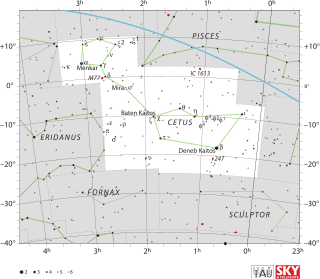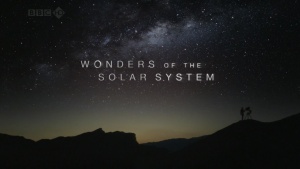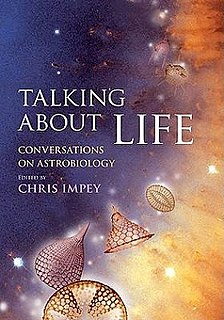
Cetus is a constellation. (The) Cetus was a sea monster in Greek mythology as both Perseus and Heracles needed to slay, sometimes in English called 'the whale'. Cetus is in the region of the sky that contains other water-related constellations: Aquarius, Pisces and Eridanus.

Extraterrestrial life is hypothetical life which may occur outside of Earth and which did not originate on Earth. Such life might range from simple prokaryotes to beings with civilizations far more advanced than humanity. The Drake equation speculates about the existence of intelligent life elsewhere in the universe. The science of extraterrestrial life in all its forms is known as astrobiology.

Equuleus is a constellation. Its name is Latin for "little horse", a foal. It was one of the 48 constellations listed by the 2nd century astronomer Ptolemy, and remains one of the 88 modern constellations. It is the second smallest of the modern constellations, spanning only 72 square degrees. It is also very faint, having no stars brighter than the fourth magnitude.

Star clusters are large groups of stars. Two types of star clusters can be distinguished: globular clusters are tight groups of hundreds to millions of old stars which are gravitationally bound, while open clusters, more loosely clustered groups of stars, generally contain fewer than a few hundred members, and are often very young. Open clusters become disrupted over time by the gravitational influence of giant molecular clouds as they move through the Galaxy, but cluster members will continue to move in broadly the same direction through space even though they are no longer gravitationally bound; they are then known as a stellar association, sometimes also referred to as a moving group.

Taurus is one of the constellations of the zodiac and is located in the Northern celestial hemisphere. Taurus is a large and prominent constellation in the northern hemisphere's winter sky. It is one of the oldest constellations, dating back to at least the Early Bronze Age when it marked the location of the Sun during the spring equinox. Its importance to the agricultural calendar influenced various bull figures in the mythologies of Ancient Sumer, Akkad, Assyria, Babylon, Egypt, Greece, and Rome. The symbol representing Taurus is , which resembles a bull's head.

Monoceros is a faint constellation on the celestial equator. Its name means unicorn in Greek. Its definition is attributed to the 17th-century Dutch cartographer Petrus Plancius. It is bordered by Orion to the west, Gemini to the north, Canis Major to the south, and by Hydra to the east. Other bordering constellations include Canis Minor, Lepus, and Puppis.

Indus is a constellation in the southern sky first professionally surveyed by Europeans in the 1590s, namely Dutchmen, and mapped on a globe by Pieter Platevoet (Plancius) by early 1598 and thus included in Bayer's keynote, consolidated sky atlas of 1603. On average it is centred, that is to say its zenith, is over 25° south of the Tropic of Capricorn. South of the Tropic lie only four countries, the rest being parts of oceans and Antarctica and ten countries straddle the tropic but the bright right-angled triangle can be seen for most of the year from the Equator. It has a north-south elongated, complex scope and its other English direct translation of its name is sometimes seen in old writings, the Indian as it is in other European languages.

A deep-sky object (DSO) is any astronomical object that is not an individual star or Solar System object. The classification is used for the most part by amateur astronomers to denote visually observed faint naked eye and telescopic objects such as star clusters, nebulae and galaxies. This distinction is practical and technical, implying a variety of instruments and techniques appropriate to observation, and does not distinguish the nature of the object itself.

David W. Hughes was a professor of astronomy at the University of Sheffield, where he worked since 1965. Hughes has published over 200 research papers on asteroids, comets, meteorites and meteoroids. He has also written on the history of astronomy, the origin of the Solar System and the impact threat to planet Earth.

Ian William Ridpath is an English science writer and broadcaster best known as a popularizer of astronomy and a biographer of constellation history. As a UFO sceptic, he investigated and explained the Rendlesham Forest Incident of December 1980.

Tommy Tomorrow was a science fiction hero published by DC Comics in several of their titles from 1947 to 1963. He first appeared in Real Fact Comics #6. He was created by Jack Schiff, George Kashdan, Bernie Breslauer, Virgil Finlay, and Howard Sherman. The comic was originally intended to feature non-fiction tales in the style of Ripley's Believe It or Not; Tommy Tomorrow's trip to Mars was presented as a future vision of space travel. The strip was a back-up feature in Action Comics from issue #127 to #147.
Astronomy Now is a monthly British magazine on astronomy and space. According to the Royal Astronomical Society, Astronomy Now is the "principal amateur astronomy magazine in Britain" with a reputed circulation of 24,000.

Nigel Henbest FRAS is a British astronomer, born in Manchester and educated in Northern Ireland and at Leicester University, where he studied physics, chemistry and astronomy. He did postgraduate research at the University of Cambridge before becoming a freelance science writer. He has written more than 40 books, many in collaboration with Heather Couper, and over 1,000 articles on astronomy and space which have been translated into 27 languages. Previously he has been Astronomy Consultant to New Scientist magazine, editor of the Journal of the British Astronomical Association and media consultant to the Royal Greenwich Observatory. Along with Couper and Stuart Carter, director of the Channel 4 series The Stars, he set up Pioneer Productions where he produced award-winning television programmes and series. Asteroid 3795 Nigel is named after him.

Celestial cartography, uranography, astrography or star cartography is the fringe of astronomy and branch of cartography concerned with mapping stars, galaxies, and other astronomical objects on the celestial sphere. Measuring the position and light of charted objects requires a variety of instruments and techniques. These techniques have developed from angle measurements with quadrants and the unaided eye, through sextants combined with lenses for light magnification, up to current methods which include computer-automated space telescopes. Uranographers have historically produced planetary position tables, star tables, and star maps for use by both amateur and professional astronomers. More recently computerized star maps have been compiled, and automated positioning of telescopes is accomplished using databases of stars and other astronomical objects.
The Science of Aliens is a touring exhibition that launched at the London Science Museum in October 2005. It was developed by a company called The Science of... set up by The Science Museum and Fleming Media. Two versions of the exhibition are touring venues around the world.
Richard Grossinger is an American writer, anthropologist, and founder of North Atlantic Books in Berkeley, California.

Wonders of the Solar System is a 2010 television series co-produced by the BBC and Science Channel, and hosted by physicist Brian Cox. Wonders of the Solar System was first broadcast in the United Kingdom on BBC Two on 7 March 2010. The series comprises five episodes, each of which focuses on an aspect of the Solar System and features a 'wonder' relevant to the theme. The series was described as one of the most successful to appear on BBC Two in recent years. An accompanying book with the same name was also published.

Talking About Life: Conversations on Astrobiology is a non-fiction book edited by astronomer Chris Impey that consists of interviews with three dozen leading experts on the subject of astrobiology. The subject matter ranges from the nature and limits of life on Earth to the current search for exoplanets and the prospects of intelligent life in the universe. The book was published as a hardcover by Cambridge University Press in 2010.
The following outline is provided as an overview of and topical guide to Mars:















